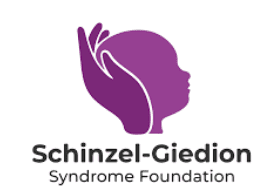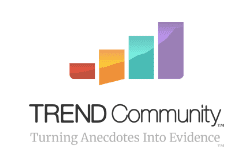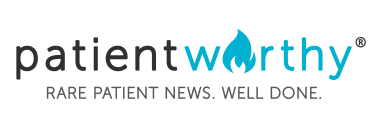In our second installment from our series of reports provided by our partner TREND Community, we are going to be focusing on a different condition over four weeks. This week we bring to you TREND’s launch report summarizing Schinzel-Giedion Syndrome community analysis showcasing the themes discussed over social media in 2024. To read week 1’s report on Myasthenia Gravis, click here, week 2’s report on IgG4-RD, click here, and week 3’s report on Chromosome 8P, click here.
TREND Community is a community-powered digital analytics company that turns the conversations of rare and chronic disease
communities into actionable insights. With the help of our community stakeholders, our AI engine, Krystie™, turns real-world
discussions into insights that can spark broader understanding and therapeutic progress. Patient Worthy is grateful to TREND Community for the permission to share this information.
Actionable Community Insights
The Role of Evidence in Progress
The pace of progress is always accelerating. Innovations in technology, combined with regulatory incentives, are helping biotechs and pharmaceutical companies bring therapeutics and medical devices to patients faster than ever.
Unfortunately, most innovations are limited to finding treatments for diseases that are already well understood—that is, innovation in the rare disease space is lagging. In fact, 95% of the 10,000+ rare diseases have no approved treatments.
True understanding of rare diseases is the bottleneck. That’s why the data and insights we capture from real patient voices are paramount to innovation. Our work unveils greater insights into disease presentation, symptoms, comorbidities, patient burden, and larger patterns. Ultimately, it is this holistic understanding that accelerates the development and approval of new therapeutics for which our communities are desperately waiting.
TREND’s Real-World Impact
From Community Voice Reports to peer-reviewed journals, the insights we glean from community conversations are translating to real-world impact. Visit our website to view posters, reports, abstracts, and other publications that we’ve co-created with our community partners.
“The Community Voice Report helped us evolve from a Facebook group to a respected organization that is making a real difference in the HIE community.”
—Betsy Pilon,
Executive Director, HOPE for HIE
How It Works
Trusted, Invite-Only Partnerships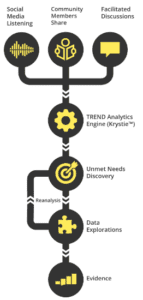
We establish trusted, long-term partnerships with invite-only online communities that are formed organically by people affected by rare, chronic, and emerging diseases.
Proprietary Analytics
We harness machine learning and natural language processing techniques using Krystie™, our proprietary analytics engine that captures the perspectives and experiences of people within these trusted communities.
Evidence Acceleration
We discover insights on disease impacts and unmet needs. Our Community Voice Report and other real-world evidence can be leveraged for many different audiences and objectives.
Analysis Background
Schinzel-Giedion Syndrome (SGS) stands as an exceptionally rare genetic disorder characterized by a complex array of physical, developmental, and neurological manifestations. Initially delineated in 197 by Swiss pediatricians Albert Schinzel and Andres Giedion, the syndrome stems primaril from spontaneous mutations in the SETBP1 gene located on chromosome 18, with cases typically not inherited from parents. This gene’s role in regulating gene expression and cell growth underscores its significance in the development and progression of SGS1. SGS is characterized by global neurodevelopmental impairment leading to moderate-to-profound intellectual disability, epilepsy (often refractory to treatment), hypotonia, spasticity, dysautonomia, hearing loss, and cerebral visual impairment. Other findings can include poor weight gain often associated with gastroesophageal reflux disease, chronic vomiting, constipation, gastroparesis, and/or feeding intolerance. Structural malformations can involve the heart, skeleton, kidney and urinary tract, genitalia, and brain. Anomalies of the liver, spleen, and/or pancreas are less common. Other features may include neuroepithelial neoplasia, severely disrupted sleep, choanal stenosis, inguinal hernia, sensitive skin, and increased risk of infection.2
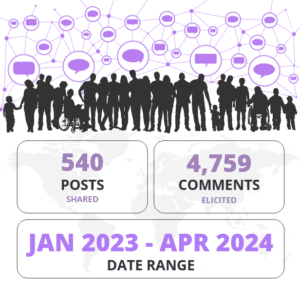
Although there exists no cure for SGS, management strategies predominantly center on providing supportive care tailored to address the individual’s specific symptoms and needs. Given the rarity and complexity of the condition, a comprehensive approach involving geneticists, pediatricians, neurologists, and developmental specialists is paramount in ensuring holistic care and support for affected individuals and their families.
The mission of the Schinzel-Giedion Syndrome Foundation is to provide support for families caring for a child with Schinzel-Giedion Syndrome (SGS), raise awareness of SGS, and facilitate and support medical research.
To illustrate the most frequent words used by community members, a word cloud was generated. Some of the most frequent words included thank, help, and love. Words associated with medical experiences included family and child. Various words also denoted timing, such as day, month, year, and time.
The most frequent body parts mentioned across posts and comments were extracted. The most frequent, Kidney, accounted for 14.6% of all body part mentions. Other internal organs included Brain, Bladder, and Heart.
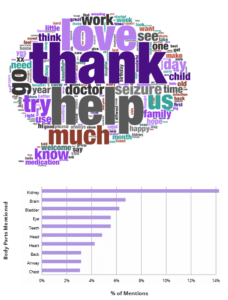
Topics in the Community
Medical advancements have the potential to profoundly impact and reshape the characteristics of diseases over time. By actively listening to the community, we can gain valuable insights into these shifts when they happen. Our analysis involves clustering language that has similar meaning and occurs in similar contexts. This process is called topic modeling. The most frequent 15 topics are presented to the right. The largest topic was seizures (205 posts/comments), followed by sending prayers/hope (162 posts/comments). Topics in the middle included feeding tubes (72 posts/ comments) and secretion management (56 posts/comments). The smallest topics, among the top 15 overall, included medication effects (38 posts/comments) and respiratory issues (38 posts/comments).
It should be noted that the overall contents of the documents labeled “secretion management” (with top keywords “saline”, “suction”, “secretions”, “mucus”, and “chest”) and “respiratory issues” (with top keywords “oxygen”, “apnea”, “sleep”,”cpap”, and “breathing”) were distinct enough to warrant a separation of the topics.
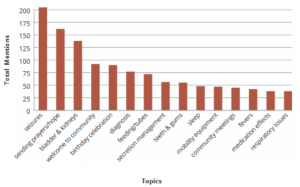
“Always advocate. No one knows your baby better than you.”
— Community Member
Clinical Findings and Medical Substances
TREND’s engine is trained to identify terms related to clinical language. Through this process, we can see the most frequently mentioned clinical concepts across clinical/medical domains. Two overarching clinical categories are presented here: Clinical Findings and Medical Substances. “Clinical Finding” refers to any sign, symptom, or other phenomenon related to a disease and its presentation. “Medical Substances” refers to any pharmaceutical medication and/or substance referenced for medicinal purposes. The top figure to the right illustrates the most common clinical findings (e.g., >35% of clinical findings mentions was seizures). The bottom figure to the right illustrates the most common substances discussed (e.g., >8% of medical substances mentions was antibiotics).
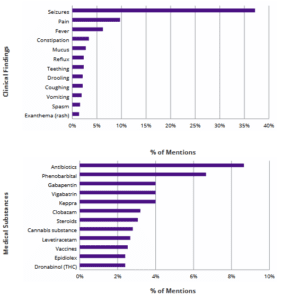
Frequently Asked Questions
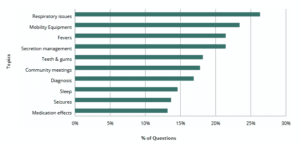
Community members often turn to their online support groups to find answers. Their questions can provide us with insights into the unmet needs of the community. For the most popular community topics (see Topics in the Community on page 6), we analyzed the proportion of questions included in conversations. This figure shows the topics with the largest proportion of questions. Specifically, the figure shows the highest frequency topics (y-axis) and the percentage of conversations that included questions (x-axis). For example, 26.3% of all conversations about respiratory issues involved a question. This list gives us insight into possible gaps in resources and the community’s need for education and support.
Emotion Classification
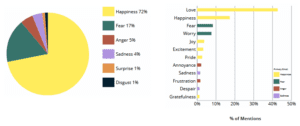
Krystie™ captures emotion language used by community members. After extracting emotions referenced, we can categorize them in six primary emotion categories (pie plot). We can then visualize the specific emotions mentioned in each category (bar plot). The most frequently expressed emotions fall under the categories of happiness and fear. Words and phrases associated with happiness included sending love, speedy recovery, family, and hugs. Words associated with fear included concern, diagnosis, and hospital.
Physician Network Analysis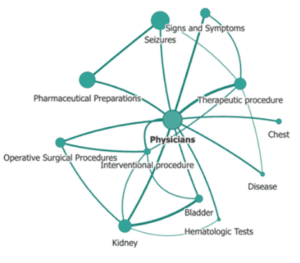
This figure reflects the Physician network in the SGS community. This network shows the concepts that co-occurred (i.e., occurred in the same post/comment) the most with the concept, Physicians (e.g., ‘doctor’, ‘dr’, ‘physician’, ‘doc’). The larger the node (i.e., circle), the more the concept was mentioned. The thicker the edge (i.e., connecting line), the more the concepts were mentioned together. This provides a general indication of the clinical findings, testing, and management techniques that might be most frequently discussed with medical professionals. In this network, some prevalent categories included body parts (e.g., chest, kidney, bladder) and procedures (e.g., Operative Surgical, Therapeutic).
“I am so grateful to have found this group.”
— Community Member
Discovering Unmet Needs
Seizures
Seizures were a consistent feature across various analyses.
Management techniques
Both pharmaceutical and non-pharmaceutical management techniques were prevalent and had a high proportion of questions (e.g., mobility equipment, secretion management, medication effects). The community may benefit from specific resources regarding the best approaches for common day-to-day management.
Navigating treatment
A diverse range of procedures was found in the Physician network. With so many options and potential interventions to consider, a substantial burden might be placed on caregivers as they navigate the range of management options available and coordinate care.
Mental health
An encouraging finding in this report relate to the positivity in the SGS community. Many topics related to the concept of community (e.g., topics like birthday celebrations, welcome to the community, community meetings). Positive emotions were associated with community language (e.g., sending love/prayers). The findings suggest the SGS is a supportive, tight knit group. Yet, it is important to note that more than 20% of emotion language relate to fear and anger and topic included a range of themes relating to symptoms, treatments, and interventions. Rare disease burden and management create a unique experience for caregivers that can negatively impact menta health. Increased support resources, outside the community, could benefit caregivers in their journey.
“It feels like we are making major decisions every day.”
— Community Member
Appendix
Endnotes
1 “Home-Schinzel-Giedion Syndrome Foundation.” Schinzel-Giedion Syndrome Foundation, 18 May 2024, sgsfoundation.org/.
2 Duis J, van Bon BWM. Schinzel-Giedion Syndrome. 2024 Mar 7. In: Adam MP, Feldman J, Mirzaa GM, et al., editors. Gene Reviews® [Internet] Seattle (WA): University of Washington, Seattle; 1993-2024. Bookshelf URL: https://www.ncbi.nlm.nih.gov/books/NBK601394/
Acknowledgments
Thank you to the Schinzel-Giedion Syndrome community members for sharing their experiences. We are grateful to Nuala Summerfield and Dana Bradley for enabling access to the data used to create this report, providing their thought leadership, and amplifying the voices of people living with Schnizel-Giedion Syndrome by co-sponsoring this Community Voice Report.
TREND Community Sponsor
